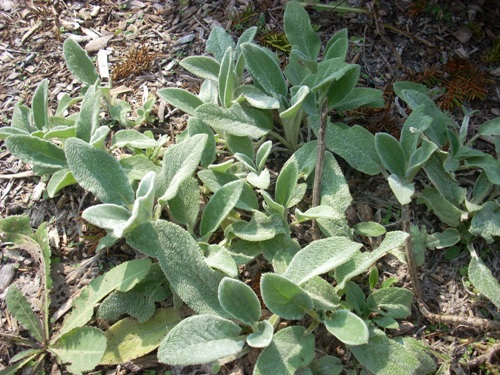Recently, my children and I stopped to take a walk around a small lake. As we were walking, we found a circular abandoned garden with large hedges around it, shielding it from view. The garden had been divided into sections, but there was nothing growing. There was a shrub or two scattered around, some dead vines trailing off arbors, and a gravel path running through the whole thing.
My first instinct was to go. There couldn’t be anything to see here, could there? And then a bright yellow and black butterfly suddenly sprang from the rocks right near our feet and flew away. As we walked, even more sprang up, seemingly from nowhere. We figured out that with their wings closed, the butterflies were a dull brown – a perfect blend for the gravel beneath us.
“Mom, let’s stay!” the kids chorused, so we continued walking. Suddenly I spotted a small patch of lamb’s ear, a plant with soft, woolly ears just like a lamb’s. I knew this plant from the ‘touch and feel’ garden at our local arboretum. We knelt down and rubbed the leaves between our fingers, marveling at the softness.
My daughter leaned in to explore at the abandoned garden:

The soft, silky lamb’s ear plant that we found hidden in the abandoned garden:

As we continued our wanderings, we ended up seeing spiders, bees, two kinds of grasshoppers (brown and green), a rabbit that dashed by us unexpectedly, a cicada, and small balloon-shaped seed pods. I think we ended up spending 30 minutes exploring the garden, our discoveries made all the more special since we hadn’t expected to find anything there.
Later, as I was telling my husband about our explorations, I began to realize that many times we miss things just because we don’t take the time to look for them. Kids are often better at noticing small details than adults are, but whether young or old, the skill of observation can be cultivated.
Taking the Time to Watch the Children
Our Montessori work areas (whether at home or school) are a lot like the abandoned garden. If you don’t take the time to observe, you might miss the child, walking turtle-slow, carefully carrying a tray with glass pitchers to a nearby table. You might miss the look of concentration on a child’s face as they work to master a difficult task.
This sort of observation cannot be rushed. That’s just one of many reasons that we have the children work for several hours at a time, and why we encourage people to sit down and observe a little bit each day. Often, teachers and parents think, “How can I find the time to sit down and observe while the class needs me?” It can be difficult, but you must make it a priority.
I had an observation chair in every classroom I’ve worked in, and when I sat down there, the kids knew that if they had a question, they needed to search for the answer themselves or ask a friend before coming to me. I usually had a clipboard with me and took notes so I could look over them later.
Taking the Time to Find Meaning
Kids can also be taught to look beneath the surface. They can learn to take the time to really study an animal before they draw it. Or to read a story several times until they really “get” what the author is trying to say.
We can encourage them by giving them plenty of time to observe. I think of a child standing in front of a fishbowl, watching the fish lazily swim. A minute might seem like enough, but think of what they can observe if they have ten minutes to watch the fish. Time is the necessary companion of observation.
Taking the Time to Get to Know the Children
Every child has a secret inner life that is not readily apparent. Even if we live with that child, we may not know much of what goes through their heads. There are fears, dreams, questions, and ideas that the child may not always feel comfortable sharing.
Sometimes when we talk to kids, we quickly answer their questions and move on. Taking a few extra minutes to ask them some questions in return can reveal more about why they’re asking questions. There may be something bothering them that we can’t see until we look beyond the initial question.
The Reward of Looking Beneath the Surface
Many times, great discoveries result when we notice what others miss. Once you take this unhurried time to observe and explore, you will discover exactly what we did at our abandoned garden: there is much to see when you take the time.

